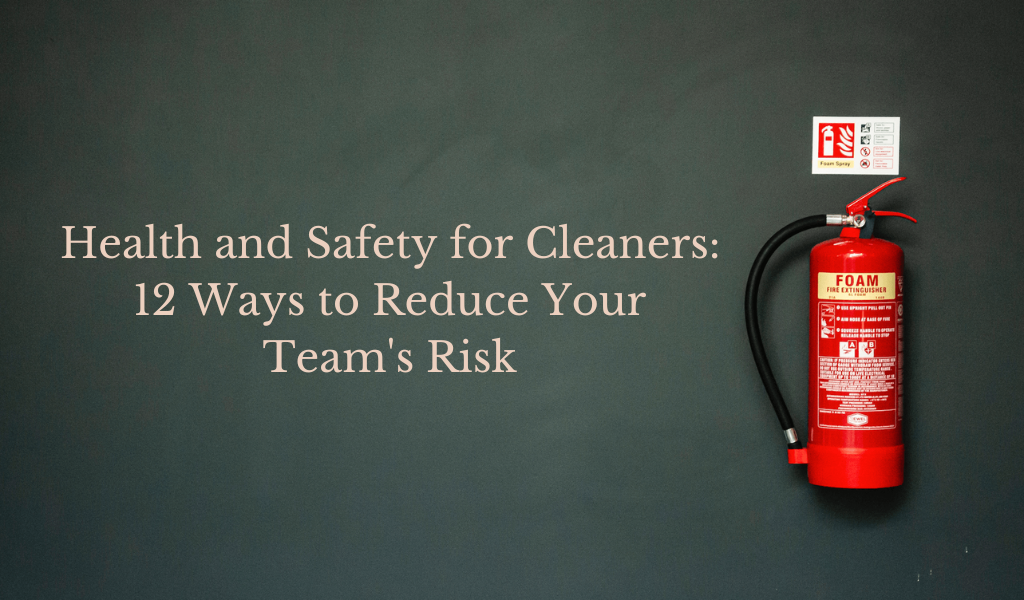Focus on health and safety for cleaners on your team so they can focus on providing high-quality work for your clients.
On the surface, it seems like the commercial cleaning industry would have minimal risks. Of course, we know that’s not true. Cleaning involves working with hazardous or toxic chemicals on occasion and being in environments with the potential for a slip and fall injury or injuries caused by repetitive motions. It is because of these risks that it is essential to focus on ways to improve health and safety for cleaners out in the field.
While you can remind cleaners to ask for help when lifting heavy objects and to tread carefully on wet floors, there still are additional ways to prioritize health and safety for cleaners and to help them understand what’s at risk.
Keep track of inventory, work orders, and more with Janitorial Manager! Learn more today with a free discovery call!

Reducing Risk and Making Health and Safety for Cleaners a Priority
1. Do a risk assessment on your walkthrough. As you do your walkthrough and make plans to bid on a job, take an extra moment to note any risks or potentially hazardous situations, such as a janitorial closet with poor ventilation, easily blocked entrances and exits, uneven flooring, and non-secure railings.
2. Use a color-coded cleaning system. There are many benefits to a color-coded system. When it comes to health and safety for cleaners, color coding can help overcome language barriers and alert people to potentially hazardous cleaning chemicals.
3. Use translation software. While we’re on the subject of different languages at work, it’s worth mentioning that software like Janitorial Manager can allow your employees to receive messages in their preferred language. That makes communicating safety issues much easier and effective.
4. Label containers and spray bottles. All you need is some masking tape and a Sharpie to label containers. It’s a simple and effective way for everyone to know what a bottle contains.
5. Use eco-friendly cleaners. Most eco-friendly cleaners don’t cause the same irritation as chemical cleaners. This comes with some caveats, though. To begin, even the most gentle cleaning products can cause irritation in concentrated contact. Secondly, there are no rules around the usage of terms like “eco-friendly,” “natural,” or “green.” Therefore, if you use eco-friendly or green cleaning products, look for those certified by the EPA’s Safer Choice program or Design for the Environment (DfE).
6. Provide proper PPE. PPE isn’t just for coronavirus. Depending on the chemicals you use or the spaces you clean, PPE might be recommended, if not required. Ensure your team has a good supply of the protective gear they need for any situation they may encounter.
7. Require non-slip shoes. These may already be required where you work, but if they aren’t, non-slip shoes can effectively reduce slipping on wet surfaces and improve health and safety for cleaners.
8. Invest in ergonomic cleaning equipment. Commercial cleaners spend much of the day bending, twisting, and reaching. But you can improve health and safety for cleaners by investing in long-handled tools and equipment that’s light and easy to move.
9. Schedule in teams. It doesn’t always make sense to have two or more employees cleaning one location, but if it is at all reasonable, working in teams is a great way to help people stay safe. Working in teams is also beneficial in that if there is an accident, it’s easy for someone to get help.
10. Train your teams on equipment. Health and safety for cleaners aren’t just about the environment they’re working in. The equipment they use can also cause harm if it isn’t used correctly. For example, floor buffers, steam cleaners, and other janitorial equipment include moving parts, hot sections, and pinch points. That’s why it’s important to train your team and ensure everyone using the equipment knows what they’re doing.
11. Make a note of fire exits. Any time your team begins working in a new space or a new person joins an established group, be sure they know where the fire exits are in case of an emergency.
12. Use geofencing. Geofencing is helpful in several ways. For example, your employees can use it to clock in or out, it helps you determine the amount of time your team spends at a facility, and you can provide clients with verification that your team was there. Concerning health and safety for cleaners, geofencing can also alert you if someone doesn’t show up. Similarly, if they are there longer than anticipated, you can check in on them and send help if necessary. Software like Janitorial Manager has a geofencing feature built-in, making it an easy solution.
Of course, there are a lot of ways to watch out for the safety of your team. You can read through some more ideas here. These 12 can get you started and go a long way in ensuring the health and wellbeing of your team is on the right track.
Harness the value of Janitorial Manager to grow your cleaning business like never before. Learn more today with a free discovery call and find out how to make your cleaning operation more efficient and cost effective!

